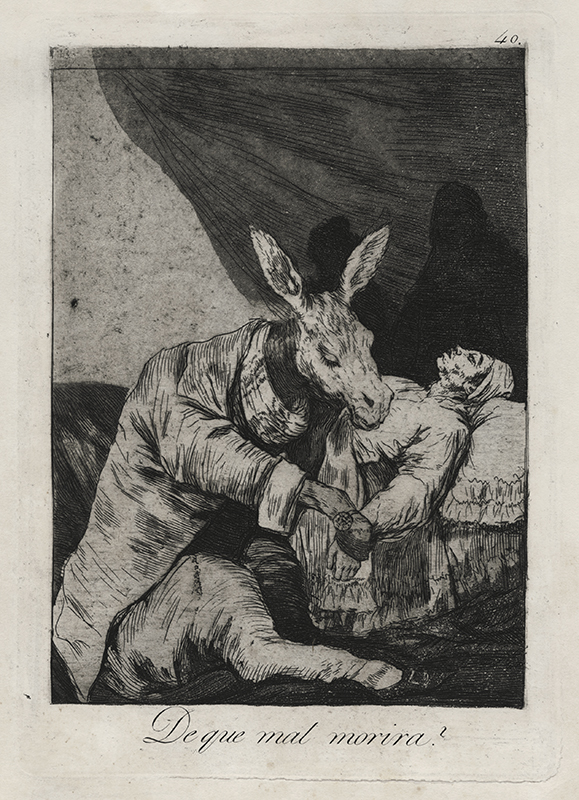
19th, 20th & 21st Century Fine Prints
707-546-7352 · fax 707-546-7924 · web: www.annexgalleries.com · email: artannex@aol.com
De que mal morira? - pl. 40 from Caprichos (What illness will he die from?) by Francisco Goya

De que mal morira? - pl. 40 from Caprichos (What illness will he die from?)
Francisco Goya
De que mal morira? - pl. 40 from Caprichos (What illness will he die from?)
Francisco Goya
1746 - 1828 (biography)The title of this piece translates to “How badly will he die?” or “Of what will he die?” In it, a donkey dressed in a suit tends to an ailing man, who lies upon what is likely his deathbed. The donkey grabs the man’s wrist with his hoof, on which an ostentatious ring can be seen. The animal – an allegorical representation of a doctor – focuses intently on what he is doing, wearing a thoughtful expression. In the background, Goya has added two shadowed figures awaiting the doctor's verdict for the patient who has little chance of overcoming his illness.
According to Funacion Goya, 'A clear and concise reading of this engraving is provided in the manuscript of the National Library, on which the following is said: "It is not necessary to ask what evil the patient who pays attention to beastly and ignorant doctors has died of."'
While the 1700s represented a time of great advances in European medicine, it was on the heels of centuries of religion-fueled fear and political power grabs that prevented the study of medicine from advancing. For Spain, figures such as Englishman William Cullen (1710 - 1790) and the Dane Hermann Boerhaave (1668 - 1738) would spur change in the outlook of medicine and doctors, as well as Spaniard Andrés Piquer y Arrufat (1711 - 1772). In particular, during the reign of Carlos III, in the year 1771, the medical teachings taught at the University of Salamanca were updated to reflect the contributions of Boerhaave.
Goya lashes out harshly in this engraving against charlatan doctors, as well as those who put themselves in their hands. In this way he questions in the title of the print what will be the cause of his death: illness, or the incompetence of the doctor? In some cases this image has been interpreted as a veiled reference to Manuel Godoy (Badajoz, 1767- Paris, 1851) and the disastrous way in which he governed the country. This engraving is part of the set of prints within the Caprichos called "asses", in which the images feature donkeys who serve to censor human stupidity.


